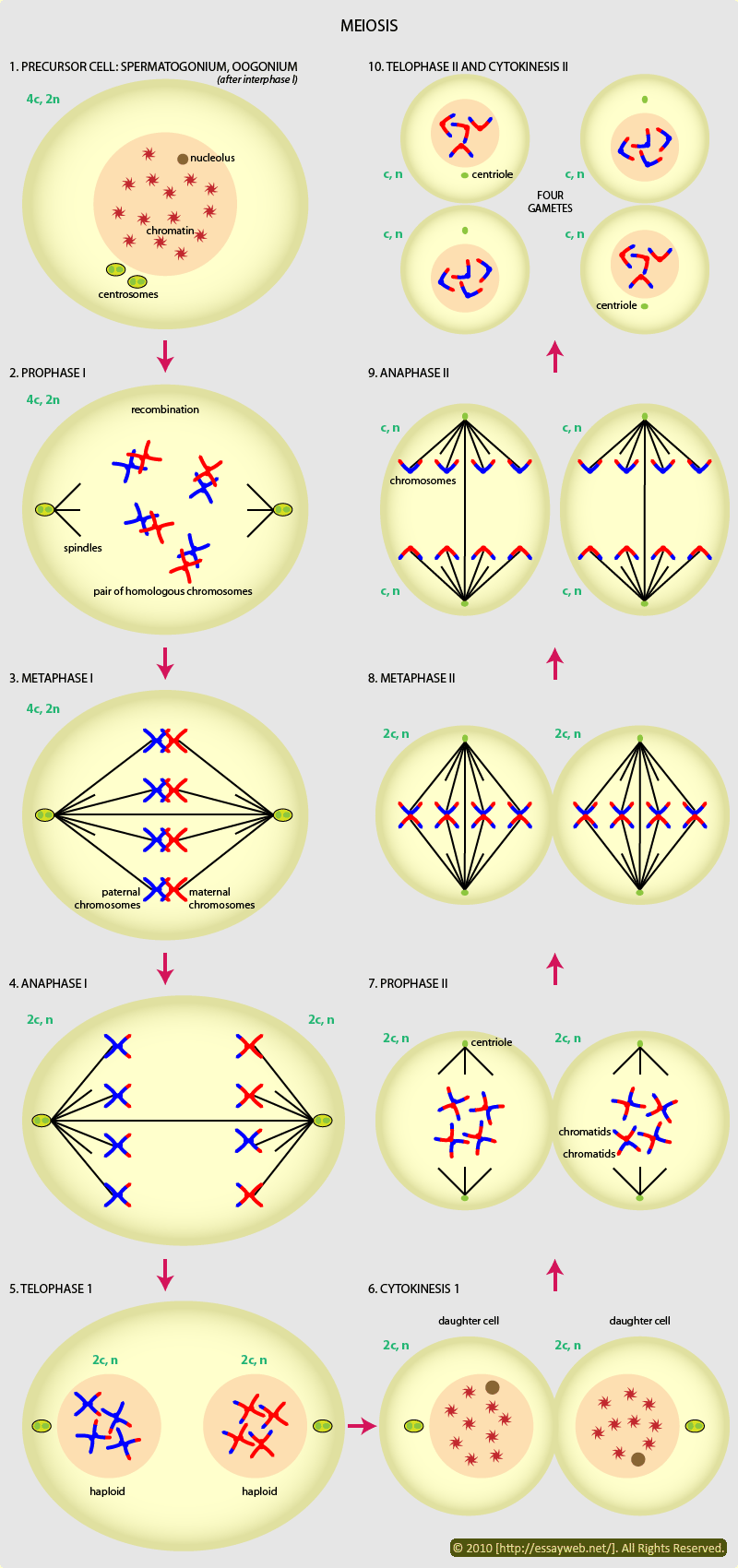During the process of reducing the number of chromosomes by half, the combination of alleles are rearranged to give recombinant gametes. Two distinct processes are involved. These are independent assortment of chromosomes and crossing-over.
Meiosis involves twosuccessive divisions, resulting in producing four cells, each containing half the number of chromosomes of the mother cell. There is NO replication between the two divisions.
We call the two divisions meiosis I and meiosis II, as in Chinese 减数第一次分裂 and 减数第二次分裂. Here we will introduce more of meiosis than meets in high school textbooks.
Meiosis I
meiosis I is divided into prophase, metaphase, anaphase and telophase. Although they have the same names as the four phases in typical mitosis, behavior of chromosomes in these four phases in meiosis is very different from that in mitosis.
In prophase each chromosome pairs with its homolog (copy of the same chromosome inherited from the other parent). The paired chromosomes are called bivalents. Each pair is held together by chiasmata(plural of chiasma). The exchange of genetic material is known as crossing-over.
A chiasma (plural: chiasmata), in genetics, is thought to be the point where two homologous non-sisterchromatids exchange genetic material during chromosomal crossover during meiosis (sister chromatids also form chiasmata between each other, but because their genetic material is identical, it does not cause any change in the resulting daughter cells). (from wikipedia)
- Prophase of meiosis is subdivided into five stages: leptotene, zygotene, pachytene, diplotene, and diakinesis.
- In leptotene(literal translation:thin threads), the chromatin is seen to condense into very long thin strands, that appear tangled in the nucleus. As prophase proceeds chromosomes become shorter and thicker.
- At zygotene(literal translation: yoked/linked threads), homologous chromosomes are seen as partially paired structures. They are still very elongated at this stage and chromosome pairs may overlap or interwine.
- By patchytene(thick threads), pairing is complete, though it still isn’t possible identify clearly the individual chromatids in each bivalent.
- As the homologous chromosomes begin to separate, transition from patchytene to diplotene(double threads) occurs.
This process begins at the centromeres and the bivalents are seen to be held together by chiasma.
The nuclear membrane and the nucleolus breaks down.
The four chromatids in each bivalent become identifiable and individual chiasma clearly to be identified.
- Chromosomes carrying on condensing, the cell moves into diakinesis(moving apart), the final subdivision of prophase I.
The scheme below shows the five stages in prophase in a simple way:
At metaphase I the nuclear envelope breaks down, the bivalents lie across the equator of the cell with their centromeres attached to the microtbules←similar to the spindle in mitosis.
The dynamic action of the spindle causes one member of each homologous cell to move to the opposite poles of the cell.
↑WHY wouldn’t the action of the spindle tear apart the sister chromatids?
BECAUSE at metaphase the sister chromatids are held together by proteins called cohesions, which holds chiasmata in place and so holds the chromosomes together.
At anaphase I the cohesions in the chromosome arms are cut, allowing the homologs to separate.
In telophase I, two neclei form around the segregating chromosomes and a degree of chromosome decondensation is observed.
Meiosis II
The process of meiosis II closely resembles that of the typical mitosis.
In prophase II the chromosomes are seen to recondense within the two nuclei. At metaphase II, the nuclear membrane breaks down and chromosoms rearranged at the equator , the centromere splits and…At anaphase II and telophase II,the initial dipliod cell has divided into four…we already knew these in high school.
What we didn’t know in high school is that each of the four haploid cells has a different genotype. And in many instances the group of four haploid cells may remain together and is known as a tetrad.
SUMMARY OF MEIOSIS

